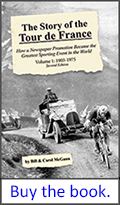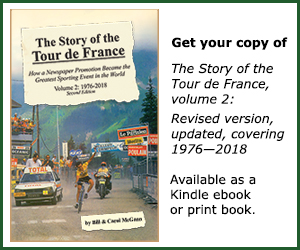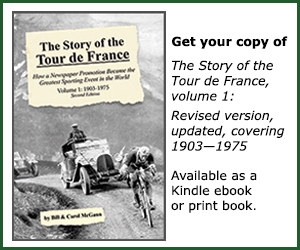

Wheel Building:
Part 2: Tensioning A Wheel
by John Neugent
Back to list of tech articles | Wheel building part 1 | Wheel Building part 3
John Neugent probably knows more about bicycle wheels than anyone else alive. Maybe more about bikes as well. He's spent his life in the bike business, at every level. He now owns Neugent Cycling, a firm devoted to delivering world-class equipment at the lowest possible price. If you are in the market for a set of wheels, please, check out John's site. He really knows his stuff. —Chairman Bill

John Neugent
This is the second part in a multipart series.

Bill & Carol McGann's book The Story of the Tour de France, Vol 1: 1903 - 1975 is available as an audiobook here. For the print and Kindle eBook versions, just click on the Amazon link on the right.
John Neugent writes:
Tensioning A Wheel
Also: Spoke Tension: a closer look
Tensioning a wheel is where the rubber meets the road. It requires more skill and experience than lacing. While the steps are relatively straight forward, every wheel builds up differently and the real skill is in dealing with those differences.
The single most important thing about tensioning a wheel is to get it as round as possible. When a tire is mounted roundness is impossible to see and therefore it’s easy to disregard it. The rounder the wheel the more equal the spoke tension and the more equal the spoke tension the less likely the wheel will come out of true.
The second most important thing is to do all fine tuning at low tension. With low spoke count wheels tensions are high and nipples at high tension distort and weaken the spoke holes if they are turned too many times.
Finally, it’s important to understand that minor adjustments make a big difference. A spoke thread is 56 TPI. That means a full turn of the spoke wrench will move the nipple .018.” It’s very common, after the initial tensioning, that both the roundness and lateral trueness of a wheel is within one or two spoke turns. It’s a common mistake for beginners to overturn nipples and that’s the biggest reason things can quickly get out of control.
Drive side rear spokes: These are the key spokes in any wheel build for a number of reasons. The rear wheel is dished to accommodate the cassette. The spokes on the drive side also have to do most of the work for driving the wheel and the rear wheel also gets about 60 percent of rider weight. For this reason and the one mentioned below, I use two internal washers lubricated with dry ptfe (Teflon) on the rear drive side spokes. The washers not only increase rim strength (two .5 mm washers add 1 mm in thickness to the spoke bed – which is 2 mm thick on most alloy rims), just as importantly they make it easier to turn the spoke nipple without deforming the spoke hole.
Non drive side rear spokes: With the increase in numbers of sprockets on the cassette, rear wheels have had more and more dish to the point where the non drive side spokes tend to be fairly loose. You can’t tension them higher because it would pull the wheel out of dish. The only way to increase non drive side spoke tension is by increasing drive side spoke tension. The internal washers on the drive side allow you to do just that. You could also, in the design of the hub shell, move the non drive side flange in but that would decrease the lateral stiffness of the wheel. The less perpendicular the spoke angle, the stiffer the wheel. As long as a spoke is under any tension, it is as still as it is under high tension – that’s the nature of steel.
Initial tensioning of the wheel: I first lubricate drive side rear and front spoke threads with boiled linseed oil and do the same to all rim spoke holes. On the non drive side rear spokes I lubricate the spoke threads with Loctite 242 (blue) in an effort to do everything possible to keep those nipples from loosening after the build.

Loctite
When doing initial wheel tensioning I always do the drive side rear spokes first and then the non drive side. On the front wheel I do both sides at the same time. Normally it really doesn’t matter but if your spoke lengths are off it can be an issue.
I use a spoke nipple driver that is a flat bladed screwdriver with center shaft mounted to a drill. When the center shaft contacts the end of the spoke it spits the nipple out. This insures all of the nipples are threaded on about the same length after the process.

Spoke nipple driver
Alternately, without the special tool, you can visually thread the nipples on about the same length using the spoke threads as a guide. This is nowhere near as accurate as using the tool but I built that way for many years before the tools were readily available – it just takes longer.
Building the rear wheel. After the initial tensioning, or really just getting all of the nipples on the same amount, you need to tighten the spokes so that all of the spokes are under some tension. Always do the drive side and non drive side separately. After the initial tensioning, I normally thread the nipples on anywhere from one to six turns.
Everything I have written up to this point is pretty much automatic. It’s from this point on that really determines wheel quality. The wheel is now under a small amount of tension and more or less true. The first step is to make the lateral adjustments to get the wheel to about 1/16th of an inch true laterally. To do this it’s important to loosen one side when you tighten the other – otherwise it will adversely affect the roundness.
Once that is done, it’s time for the radial adjustment (roundness). I use a dial indicator. I find it very difficult to see the radial run out on a truing stand and just as importantly, I want to build to a spec. I build to .005” at this step. I do this primarily by taking out “the bumps” rather than “the flats.” When you tighten the nipples (you need to do both drive side and non drive side or you will lose lateral run out) it will pull the hub and affect the spokes and rim on the opposite side so I find focusing on just pulling out the bumps works better. If you have a very round rim with one flat spot then take out the flat spot. It’s rare for me to turn the spoke wrench more than ½ turn at a time. The wheel is a suspension system and it doesn’t like big changes.

Wheel truing stand with dial indicator
Once the rim is round (.005” for me) I fine tune the lateral adjustments to bring it to about the same spec. Remember that when you tighten a non drive side spoke you need to loosen the drive side or it will throw the radial adjustment. Because the drive side spoke is more vertical, it affects the radial adjustment more than the non drive side spoke so if I tighten the non drive spoke 1/2 turn I would loosen the drive side spoke 1/4. I like to get the lateral trueness to about .002" or 1/8 of a turn on a spoke wrench.
Every rim has a weld or seam where the rim joins. Rims are made by rolling extruded bars into a coil which are then sawed creating the seam. Not only is there a seam, but also the extrusion mates there from a section on the bar that was the circumference of the rim apart. So this area, and the area where the valve hole are located are almost always going to be the areas that are most difficult to round out. To add insult to injury, when you are adjusting the radial run out at the seam, you are affecting the run out at the valve hole because it’s opposite. For this reason, many experienced wheel builders will put some tape at the seam (as well as the valve hole). This makes it easier for them to focus on the radial run out in these two areas.
Once the radial and lateral adjustments have been made and the wheel is still at a relatively low tension it’s time to “tune” the spokes. This is nowhere near as big a deal as some wheel companies and builders make it out to be. Often you will hear that it takes them as long to tune a wheel as it does to do the other steps. By tuning, I mean to adjust the spoke tension so that all spokes (on one side) are equal tension. If your radial adjustments are close they are all going to be pretty close when you start.
I am a self taught musician and tuning the spokes by tone comes easy to me. Some people have a problem with it because they can’t hear whether the note is higher or lower. I adjust the spokes so they are all within about a whole note. A whole note is the difference between “Do and Ray” in the “Do, Ray, Me” song we learned as kids. I find this results in a wheel that has equalized spoke tensions to within 5% (about a quarter turn of the spoke wrench).
To do this, I use the back of my thumbnail and pluck each spoke. When one is more than one note higher than the adjacent spoke I loosed the higher pitched spoke and tighten the lower pitched. I go around the wheel (one side only and this is also for front wheels) until all of the spokes are within a note. Generally this takes me less than one minute a wheel.
Once that is done, the wheel is trued and ready to be tensioned. Note all of this is done at very low tension. That is critical. It’s one of the biggest mistakes beginning wheel builders make and it’s a wheel killer.
Now take the spokes up to tension. Wheel tensiometers work by recording how much a spoke bends. You then consult a chart to find out spoke tension. I use a Park tensiometer. While it’s not as accurate as a DT Swiss, it’s accurate enough. I build front wheels to 130 KGF (on a Park tensiometer that’s 15 for CX Ray spokes and 20 for Laser spokes). The rear wheel drive side goes up to 165 (17 for CX Ray and 22 for Laser). Note that I could not get a rear wheel drive side spoke tension as high without using the double internal washers. I would both strip the nipples and most likely distort the spoke holes.
Also note that carbon wheels are generally designed to accept no more than 130 KGF so I use that on both front and rear.
Non drive side spoke tension is never measured because it’s whatever tension needed to center the rim.
Tensioning the rear wheel. Always bring the drive side spokes up first. I make it a rule never to tighten more than 3 full turns at a time (for each wheel revolution). Normally from a low tension that’s all I need to bring the wheels up to spec. After you bring the drive side spokes to tension, don’t touch them. Center the rim with the non drive side spokes – if the rim required three full turns to center it, and it was centered before, normally about one to 1-1/2 turns is all you need to center it.
Do ALL final lateral adjustments with the non drive side spokes and don’t even think about doing any radial adjustments. I like to get the lateral run out to within 1/8 spoke turn or less than .002.” Some welds or seams won’t quite allow that but almost all will.
It’s important to note that the total quality of a wheel build isn’t due to lateral wheel trueness but rather the overall quality of the build in general.
When the wheel is trued you need to stress relieve the spokes. There is only one correct way to do this. Grab two pairs of opposing spokes and squeeze them together. All of the other methods don’t work as well and can actually cause damage. By stressing the spokes you are not really seating the spoke heads or nipples, but rather stretching the spoke slightly beyond their yield point resulting in a loss of memory.
Quoting from an article from Jobst Brandt on bicycle wheel building “Because fatigue endurance of a metal at or near the yield stress is short, cyclic loads in such spokes will cause failures at high- stress points.”
There is no need to go around more than once as long as you do it right the first time.
After stress relieving the wheel do your final lateral adjustments. Often none are necessary.
Tensioning the front wheel. The only difference with the rear wheel is that you do both side at once rather than the drive side first. Exceptions to this are disc wheels which are slightly dished and I treat just like a rear wheel.
To repeat the most important points – all real truing should be done under low tension. It’s not only easier to do it while the tension is low but more importantly, it saves wear and tear on the nipples and rim. The most critical spec on a wheel is the radial run out. My spec is .005” – with the wheel at low tension. You will lose a little bit of this as you even out spoke tension and bring the wheel up to final tension – but not much. You never want to adjust radial run out on a rear wheel when the wheel is fully tensioned – it will damage the nipples and spoke holes.
John Neugent was was one of the first to establish quality hand building in Taiwan around the turn of the century. He now owns Neugent Cycling, a firm devoted to delivering world-class equipment at the lowest possible price.









